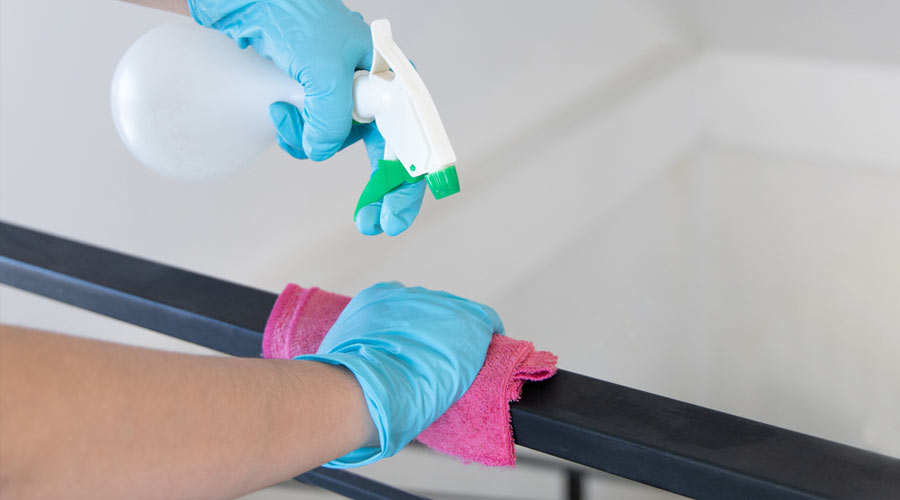
Contributed by Kurt Kuempel, Vice President, GSF USA
School and work are places where everyone deserves to feel comfortable and safe, but they can also be a breeding ground for pathogens where people can get sick. With the uptick in in-person work, school and events, cleaning and disinfecting remain two of the most important aspects of preventing any infectious disease.
Methods of Cleaning and Disinfecting
Cleaning and disinfecting offices and schools effectively can aid in killing disease-causing pathogens and reduce illness and absenteeism. The CDC has developed cleaning and disinfecting recommendations for COVID-19, which are similar to best practices for controlling other respiratory infections. Frequently used surfaces such as light switches, doorknobs, tables, bathrooms and desks are recommended to be cleaned at least once per day, especially when dirtied.
Additionally, electrostatic spraying of disinfectants is a newer technology that could be highly effective. In a study of this technology in K-12 schools, a single-use electrostatic sprayer proved effective in reducing viable microbial loads. The electrostatic sprayer operates by sending a negatively charged plume of disinfectant that covers targeted objects and can reach locations where pathogens are not readily accessible for cleaning such as with manual spray bottles and wiping. This technology is considered particularly beneficial during influenza and other infectious outbreaks, when it’s necessary to increase the frequency of disinfection.
Difference Between Cleaning and Disinfecting
Cleaning and disinfecting are different procedures that should be used in tandem to remove and kill germs. It’s possible to clean without disinfecting, but you can’t disinfect without cleaning. If you’re cleaning without the need to kill germs, then you don’t need to disinfect. But if you are looking to kill germs on surfaces, you need to disinfect after cleaning.
Cleaning is a process that involves physically removing germs, dirt and other impurities from surfaces. As a best practice when cleaning, use an all-purpose cleaning agent and microfiber cloth to lift soils away.
Disinfecting, on the other hand, kills germs but does not clean soils from surfaces. It’s necessary to use disinfectants after cleaning agents because they don’t break through soils on surfaces.
When to Clean and Disinfect
You can remove contaminants and decrease the risk of infection from surfaces by cleaning with products containing soap or detergent that reduces germs on surfaces. If no one with confirmed or suspected COVID-19 has occupied a space, cleaning once a day tends to be enough to remove viruses that may appear on surfaces. In doing so, you’re also helping maintain a healthy working environment. By disinfecting with the U.S. Environmental Protection Agency’s (EPA) List N disinfectants, you’re able to kill any remaining germs on surfaces, further reducing any risk of spreading infection.
It may be in your best interest to clean more frequently or disinfect in addition to cleaning in shared spaces if the space:
· Is in a high-traffic area where large numbers of people gather
· Is poorly ventilated
· Is occupied by people at increased risk of severe illness from COVID-19
· Does not have access to handwashing or hand sanitizer
However, if a sick person, or a person who tested positive for COVID-19, has been in the space within the last 24 hours, both cleaning and disinfection should occur.
Facility Management Responsibility
There is a responsibility among facility and custodial managers to prevent and stave off infectious diseases to protect employees, guests or students. As a first step, assessing pathogen types and levels in the space facilitates awareness. Offices, classrooms, bathrooms – any shared spaces - should be sampled to clearly define what microbes live in the space, and most importantly at what contamination levels.
The next step is to evaluate present cleaning and disinfecting practices, such as taking an inventory of your equipment, detergents and disinfectants, cleaning schedules and staff training. The mission is to ensure current environmental cleaning practices are effective. This research, working alongside a literature review and lab investigations, will likely aid in the development of a best practices cleaning and disinfection program for your facility. Furthermore, a cleaning and disinfection best practices training program for cleaning professionals would need to be developed for evaluation and implementation.
Results-Oriented Solutions
Developing effective and standardized cleaning and disinfection guidelines should have significant health benefits for your employees and guests, thanks to reduced levels of potentially harmful viruses, bacteria and fungi in facilities. When it comes to cleaning and disinfecting, it’s important to note the difference between the two and how each plays a part in keeping your facility safe and healthy.
Kurt Kuempel is the Vice President of GSF USA, a leading provider of cleaning services. For more information, visit www.gsf-usa.com or contact Kuempel at kkuempel@GSF-usa.com.

 The Down and Dirty on Cleaning in Virus Season
The Down and Dirty on Cleaning in Virus Season How Surfactant Use is Expanding in Commercial Cleaning
How Surfactant Use is Expanding in Commercial Cleaning